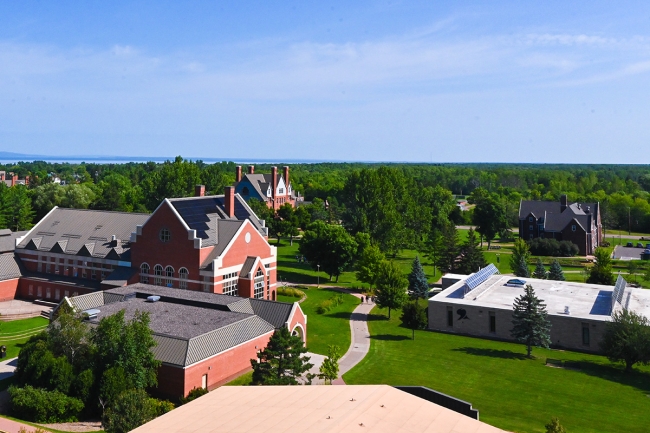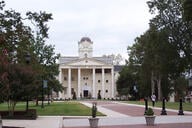You have /5 articles left.
Sign up for a free account or log in.

Northland College is located just off the coast of Lake Superior in Ashland, Wisconsin.
Wikimedia Commons
Northland College is the latest example of a growing phenomenon: higher education institutions deciding their future in (quasi-)public view.
Three weeks ago, the Wisconsin private nonprofit college suddenly announced that it would be forced to close by year’s end if it couldn’t find a $12 million lifeline by April 3. The revelation seemingly shocked students, faculty and staff members, and alumni.
Last week, the deadline came and went, and despite falling about $10.5 million short of its $12 million target, the college didn’t close.
Instead, the board on Thursday declared financial exigency and granted a two-week reprieve to explore possible program, staffing and budget adjustments that could preserve the institution’s long-term viability.
Employee and alumni groups, who say they were blindsided by Northland’s original announcement and complain that college leaders had not involved them in discussions about a path forward, had pleaded for more time. They floated a proposal, True Northland, as a financially sustainable way to keep the college open.
It would involve turning empty campus dorms into affordable public housing in a lakeside town where housing prices have skyrocketed, cutting some faculty positions and reassigning others to roles such as grant writers, adjusting curriculum to lower operational costs, and broadening the college’s mission to increase lucrative community engagement.
The college president and board chair say they had received and considered the plan relatively early in the initial three-week fundraising period, but True Northland representatives say they didn’t get a chance to fully present and discuss their model until after the April 3 deadline.
In announcing the extension, Northland leaders offered a ray of hope. “There have been positive and productive conversations taking place among the Board, leadership, faculty and campus groups, as well as the community,” President Chad Dayton said in a press release. “We are listening and agree that additional time and a defined process are valuable next steps.”
But they also continue to sound a note of caution. ”Our shared goal is to continue Northland’s mission and we are committed to ensuring we’ve explored all options to do so,” Ted Bristol, chair of the board, said in the same release. “However, I also want to caution that Northland’s circumstances remain incredibly serious and significant progress will be needed in the next two weeks to avoid closure.”
A Risk or a Reward?
Similar situations have not ended well for the college. Bloomfield College—a small private liberal arts institution in New Jersey that primarily serves Black and Hispanic students—made a parallel public plea for help in 2021 as it faced threats of closure. But the cry for donors’ dollars was to no avail. A year later, in the fall of 2022, Bloomfield announced it would merge with Montclair State, a medium-size public research university about 10 miles away. That was a positive outcome for many students and staff members, even if the institution didn’t survive as a freestanding institution.
When Bloomfield first made its financial strains public, legal experts who often advise university consolidations of colleges noted that such public announcements come with risks. Both incoming and returning students may be less likely to enroll if they are unsure they can graduate before the college closes, they said.
Yet, even knowing this, such pleas seem to become increasingly common as college and university leaders see no other option and hope that news of a closure could light a fire under students, faculty, alumni and philanthropists, sparking just the kind of investment necessary to keep the college alive.
Will Two Weeks Be Enough?
In the case of Northland, a 132-year-old college known for its emphasis on environmental sustainability, financial sustainability has long been a struggle. Tax filings in 2022 show the college had nearly $35.1 million in expenses and $31.8 million in revenues, a shortfall of roughly $3.3 million. And reporting from ProPublica shows that Northland has been operating in a similar red zone since 2016.
The college has also seen a nearly 20 percent decrease in enrollment between its peak of 645 students in fall 2017 and 518 students in 2022, data from the Education Department’s Integrated Postsecondary Education Data System shows.
Faculty members and alumni say they had some sense that the college was struggling, but that no one knew just how dire it was until the March 11 announcement.
“Up until the announcement, we were still adding faculty lines … We were not looking at cutting expenses in any way,” said Elizabeth Andre, a professor of nature and culture who chaired the faculty ad hoc committee behind True Northland. “So by cutting expenses and adding some very low-hanging fruit of additional sources of revenue … We can almost completely close the budget gap.”
But President Dayton said the dire financial status of the institution was clear to college leaders at the start of fiscal year 2024 last summer, and they immediately explored restructuring and what it would take to launch a productive multi-year fundraising campaign. But they were not able to form a plan quick enough to outpace the growth of the college’s deficits, Dayton said.
“We engaged a fantastic fundraising firm and spent many months doing a fulsome feasibility study in preparation for some type of a transformational campaign … but right about the time that we were considering launching the traditional silent phase, we got focused on the immediate fiscal realities of the institution,” he said. “We didn’t have the time to run a multi-year campaign. So we made the decision to launch an emergency fundraising appeal.”
But even after the emergency appeal was launched, faculty and alumni critics say the administration did not meet their requests to share its budget models and other financial information with them.
Dayton said the budget models were provided to a faculty welfare committee. He also said that the board “appreciates” the ideas of True Northland and will further vet the proposal over the next two weeks. He did not speak to thoughts on any specific elements of the plan or its feasibility in practice.
“As we navigate through very difficult times,” Dayton said, “it is incredibly important that the institution adhere to the principles and practices of shared governance, and we continue to maintain that shared governance as the guide rail for our work.”
Andre said the budget models Northland provided were only summaries and that the welfare committee could not share copies with any other faculty members.
“It’s disappointing that they haven’t been working with us more closely,” she said. “Up until this point, we could have been doing a lot better if we were working together.”
A group of alumni called Northland Forever raised just over $270,000 in pledged donations to help the college stay afloat. But they have yet to turn those dollars over to the college, expressing similar frustrations to those of the faculty and demanding greater transparency first.
“The Board of Trustees still has not officially acknowledged us in any way,” said Brontë Gross, a graduate who lives nearby and occasionally serves as an adjunct instructor. “We want to make sure that if we ask you to donate your money, it will go toward a community plan the trustees have agreed upon.”
Gross and Andre said some instructors and alumni wonder if board members see closure as a way to redirect investments to the Sigurd Olson Environmental Institute, a standalone community outreach facility.
(An FAQ on the Northland website lists a set of examples of what the future of Northland could be, and one of them is “an expansion of the work of the Sigurd Olson Environmental Institute.”)
“How long did they know?” about the dire financial situation, Gross wondered. “Twelve million dollars in three weeks would be hard for many schools, but for Northland especially it’s basically an already signed and secured death warrant.” Gross said. “Maybe some of the trustees see this as a way to develop their favorite parts of Northland, while getting rid of the parts that have been struggling or that they didn’t care about.”
While they remain hopeful the college can survive in some fashion, optimism is waning. Solving Northland’s problem in two weeks “is an almost impossible task,” Andre said.
“While we are pleased that the board of trustees did not announce closure, we need to acknowledge the emotional and mental impact of the timing of this announcement,” she said. “The past three weeks have been very stressful for the campus community, and a two-week extension without any promise of being open for the coming academic year is prolonging the anxiety and uncertainty many are feeling.”




